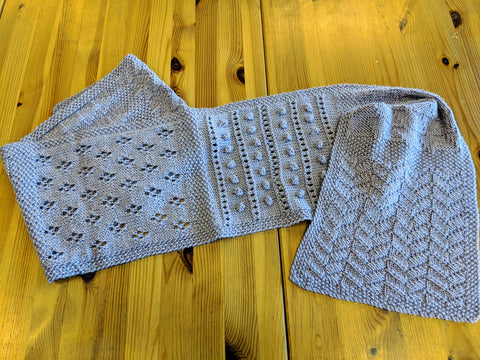Your Cart is Empty
After Christmas Sale! Shop Now > |Free USA Shipping On Orders Over $75!
After Christmas Sale! Shop Now > |Free USA Shipping On Orders Over $75!
After Christmas Sale! Shop Now > |Free USA Shipping On Orders Over $75!
After Christmas Sale! Shop Now > |Free USA Shipping On Orders Over $75!

by Kelley Hobart February 12, 2019 3 min read
I love the bookBuilding Blocks by Michelle Hunter. It is appropriate for the beginning knitters or the advanced knitter wanting a social knitting project, and she's filmed videos on each of the skills in the book. Here are some of the great things about this book:
I chose Hikoo Sueno in color 1182 Dusty Lilac for my blocks, andI'm knitting my building blocks in long strips that are six blocks long.
I'll end up knitting four of these strips, which will cut my seaming down considerably, allowing me to finish my project in less time than seaming each block to another, making the strips.
I'm also knitting 10 rows of seed stitch instead of the cast-on edge in each block, 5 rows of seed stitch at the beginning of each block, and then six rows of seed stitch and a bind-off edge at the end of the block. My method uses three fewer rows and cuts down on the amount of yarn required to knit the project.

I am planning to use eight skeins of Hikoo Sueno for the 40" X 60" throw I am currently working on. I'm using my third skein and am working on my tenth block, so I'll have enough yarn to complete at least a part of another block. That's just over three blocks per skein on a US #6 needle.
My throw will be six blocks long by four blocks wide. Remember, I'm doing strips so my yardage goes further because I'm not casting on and binding off between each block. Plus, I have a few less rows of seed stitch because I don't need the extra rows for joining each block together.
I have more technique videos available for free—hopefully these will help you in your knitting journey.
Regardless of how you proceed with your building blocks, I can assure you that you're in for a real treat as you learn a new skill with each block!
Comments will be approved before showing up.

by Meg Bateman January 02, 2022 1 min read
Do you feel lost when it comes to picking out your first knit sweater pattern? This week, Kelley shared her favorite sweater patterns during Technique Tuesday. These patterns all feature minimal seaming, have detailed instructions, and have lots of completed projects on Ravelry!
Kelley has knit the Brick Sweater several times, and has decided to knit it again with all our Technique Tuesday viewers! Grab some worsted weight yarn and join us for this informal knit along.

by Meg Bateman January 02, 2022 1 min read

by Meg Bateman January 02, 2022 1 min read
Sign up to get the latest on sales, new releases and more …